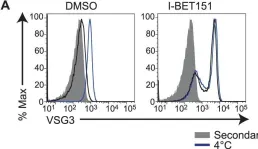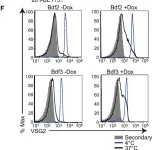After the COVID-19 pandemic, significant increases in measles cases were observed globally. Community-wide vaccination remains the most effective strategy for preventing measles. However, it is crucial to understand whether prevalent genotypes, when circulating in populations with suboptimal vaccination coverage, may undergo adaptive mutations that allow them to escape vaccine-induced immunity. In this study, a bioinformatics-guided approach was used to predict universal helper T-cell epitopes specific to the measles vaccine virus (vaccine-MeV) presented by multiple HLA-DR, -DP, and -DQ alleles to achieve population-wide coverage. By using MeV-specific T-cell lines, we identified 37 functional epitopes out of 83 predicted candidates, including 25 novel ones. Strikingly, 73% of these epitope regions were associated with sequence variations in wild-type viruses. More importantly, we demonstrated that mutations disrupted the ability of vaccine-induced CD4+ T cells to respond to circulating viruses. Consequently, mutations in epitope regions of circulating viruses may affect the effectiveness of vaccine-induced T-cell immunity.
© 2025. The Author(s).
Product Citations: 19
Impact of genotypic variability of measles virus T-cell epitopes on vaccine-induced T-cell immunity.
In NPJ Vaccines on 20 February 2025 by Emmelot, M. E., Bodewes, R., et al.
-
FC/FACS
-
Homo sapiens (Human)
-
Immunology and Microbiology
In International Journal of Molecular Sciences on 30 July 2024 by Otani, Y., Schol, J., et al.
Cell transplantation is being actively explored as a regenerative therapy for discogenic back pain. This study explored the regenerative potential of Tie2+ nucleus pulposus progenitor cells (NPPCs) from intervertebral disc (IVD) tissues derived from young (<25 years of age) and old (>60 years of age) patient donors. We employed an optimized culture method to maintain Tie2 expression in NP cells from both donor categories. Our study revealed similar Tie2 positivity rates regardless of donor types following cell culture. Nevertheless, clear differences were also found, such as the emergence of significantly higher (3.6-fold) GD2 positivity and reduced (2.7-fold) proliferation potential for older donors compared to young sources. Our results suggest that, despite obtaining a high fraction of Tie2+ NP cells, cells from older donors were already committed to a more mature phenotype. These disparities translated into functional differences, influencing colony formation, extracellular matrix production, and in vivo regenerative potential. This study underscores the importance of considering age-related factors in NPPC-based therapies for disc degeneration. Further investigation into the genetic and epigenetic alterations of Tie2+ NP cells from older donors is crucial for refining regenerative strategies. These findings shed light on Tie2+ NPPCs as a promising cell source for IVD regeneration while emphasizing the need for comprehensive understanding and scalability considerations in culture methods for broader clinical applicability.
In International Journal of Molecular Sciences on 24 November 2023 by Soma, H., Sakai, D., et al.
The angiopoietin-1 receptor (Tie2) marks specific nucleus pulposus (NP) progenitor cells, shows a rapid decline during aging and intervertebral disc degeneration, and has thus sparked interest in its utilization as a regenerative agent against disc degeneration. However, the challenge of maintaining and expanding these progenitor cells in vitro has been a significant hurdle. In this study, we investigated the potential of laminin-511 to sustain Tie2+ NP progenitor cells in vitro. We isolated cells from human NP tissue (n = 5) and cultured them for 6 days on either standard (Non-coat) or iMatrix-511 (laminin-511 product)-coated (Lami-coat) dishes. We assessed these cells for their proliferative capacity, activation of Erk1/2 and Akt pathways, as well as the expression of cell surface markers such as Tie2, GD2, and CD24. To gauge their regenerative potential, we examined their extracellular matrix (ECM) production capacity (intracellular type II collagen (Col2) and proteoglycans (PG)) and their ability to form spherical colonies within methylcellulose hydrogels. Lami-coat significantly enhanced cell proliferation rates and increased Tie2 expression, resulting in a 7.9-fold increase in Tie2-expressing cell yields. Moreover, the overall proportion of cells positive for Tie2 also increased 2.7-fold. Notably, the Col2 positivity rate was significantly higher on laminin-coated plates (Non-coat: 10.24% (±1.7%) versus Lami-coat: 26.2% (±7.5%), p = 0.010), and the ability to form spherical colonies also showed a significant improvement (Non-coat: 40.7 (±8.8)/1000 cells versus Lami-coat: 70.53 (±18.0)/1000 cells, p = 0.016). These findings demonstrate that Lami-coat enhances the potential of NP cells, as indicated by improved colony formation and proliferative characteristics. This highlights the potential of laminin-coating in maintaining the NP progenitor cell phenotype in culture, thereby supporting their translation into prospective clinical cell-transplantation products.
-
FC/FACS
In Antioxidants (Basel, Switzerland) on 15 November 2023 by Bayanbold, K., Singhania, M., et al.
The intracellular redox-active labile iron pool (LIP) is weakly chelated and available for integration into the iron metalloproteins that are involved in diverse cellular processes, including cancer cell-specific metabolic oxidative stress. Abnormal iron metabolism and elevated LIP levels are linked to the poor survival of lung cancer patients, yet the underlying mechanisms remain unclear. Depletion of the LIP in non-small-cell lung cancer cell lines using the doxycycline-inducible overexpression of the ferritin heavy chain (Ft-H) (H1299 and H292), or treatment with deferoxamine (DFO) (H1299 and A549), inhibited cell growth and decreased clonogenic survival. The Ft-H overexpression-induced inhibition of H1299 and H292 cell growth was also accompanied by a significant delay in transit through the S-phase. In addition, both Ft-H overexpression and DFO in H1299 resulted in increased single- and double-strand DNA breaks, supporting the involvement of replication stress in the response to LIP depletion. The Ft-H and DFO treatment also sensitized H1299 to VE-821, an inhibitor of ataxia telangiectasis and Rad2-related (ATR) kinase, highlighting the potential of LIP depletion, combined with DNA damage response modifiers, to alter lung cancer cell responses. In contrast, only DFO treatment effectively reduced the LIP, clonogenic survival, cell growth, and sensitivity to VE-821 in A549 non-small-cell lung cancer cells. Importantly, the Ft-H and DFO sensitized both H1299 and A549 to chemoradiation in vitro, and Ft-H overexpression increased the efficacy of chemoradiation in vivo in H1299. These results support the hypothesis that the depletion of the LIP can induce genomic instability, cell death, and potentiate therapeutic responses to chemoradiation in NSCLC.
-
FC/FACS
-
Cancer Research
In Npj Regenerative Medicine on 16 December 2022 by Hamahashi, K., Toyoda, E., et al.
Allogeneic cell therapies are not fully effective in treating osteoarthritis of the knee (OAK). We recently reported that transplantation of autologous chondrocyte cell-sheets along with open-wedge high tibial osteotomy promoted hyaline cartilage repair in humans. Here we describe our regenerative therapy for OAK using polydactyly-derived allogeneic chondrocyte cell-sheets (PD sheets) and temperature-responsive culture inserts. Ten patients with OAK and cartilage defects categorized arthroscopically as Outerbridge grade III or IV received the therapy. Cartilage viscoelasticity and thickness were assessed before and after transplantation. Arthroscopic biopsies obtained 12 months after transplantation were analyzed histologically. Gene expression was analyzed to evaluate the PD sheets. In this small initial longitudinal series, PD sheet transplantation was effective in treating OAK, as indicated by changes in cartilage properties. Gene marker sets in PD sheets may predict outcomes after therapy and provide markers for the selection of donor cells. This combined surgery may be an ideal regenerative therapy with disease-modifying effects in OAK patients.
© 2022. The Author(s).
In PLoS Biol on 1 December 2015 by Schulz, D., Mugnier, M. R., et al.
Fig.3.A

-
FC/FACS
-
Collected and cropped from PLoS Biol by CiteAb, provided under a CC-BY license
Image 1 of 2
In PLoS Biol on 1 December 2015 by Schulz, D., Mugnier, M. R., et al.
Fig.5.F

-
FC/FACS
-
Collected and cropped from PLoS Biol by CiteAb, provided under a CC-BY license
Image 1 of 2

